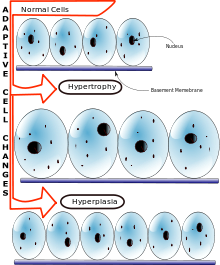Hypertrophy
This article needs more reliable medical references for verification or relies too heavily on primary sources. (May 2017) |  |
| Hypertrophy | |
|---|---|
 | |
| Hypertrophy results from an increase in cell size, whereas hyperplasia stems from an increase in cell number. |
Hypertrophy is the increase in the volume of an organ or tissue due to the enlargement of its component cells.[1] It is distinguished from hyperplasia, in which the cells remain approximately the same size but increase in number.[2] Although hypertrophy and hyperplasia are two distinct processes, they frequently occur together, such as in the case of the hormonally induced proliferation and enlargement of the cells of the uterus during pregnancy.
Eccentric hypertrophy is a type of hypertrophy where the walls and chamber of a hollow organ undergo growth in which the overall size and volume are enlarged. It is applied especially to the left ventricle of heart.[3] Sarcomeres are added in series, as for example in dilated cardiomyopathy (in contrast to hypertrophic cardiomyopathy, a type of concentric hypertrophy, where sarcomeres are added in parallel).
Gallery
| -plasia and -trophy |
|---|
|
|
See also
- Athlete's heart
- Ventricular hypertrophy (including left ventricular hypertrophy and right ventricular hypertrophy)
- Muscle hypertrophy
- List of biological development disorders
References
- ^ Hernandez, Richard; Kravitz, Len. "Skeletal muscle hypertrophy". www.unm.edu.
- ^ "Hyperplasia: MedlinePlus Medical Encyclopedia". medlineplus.gov. Retrieved 2023-02-19.
- ^ Kusumoto, F. M. (2004), Cardiovascular Pathophysiology, Hayes Barton Press, pp. 20–22, ISBN 978-1-59377-189-8
External links
- Articles with short description
- Short description matches Wikidata
- Articles needing additional medical references from May 2017
- All articles needing additional references
- Articles requiring reliable medical sources
- Short description is different from Wikidata
- Webarchive template wayback links
- Articles with BNF identifiers
- Articles with BNFdata identifiers
- Articles with J9U identifiers
- Articles with LCCN identifiers
- Muscular system
- Tissues (biology)
- Exercise physiology
- Physical exercise
- Anatomical pathology











